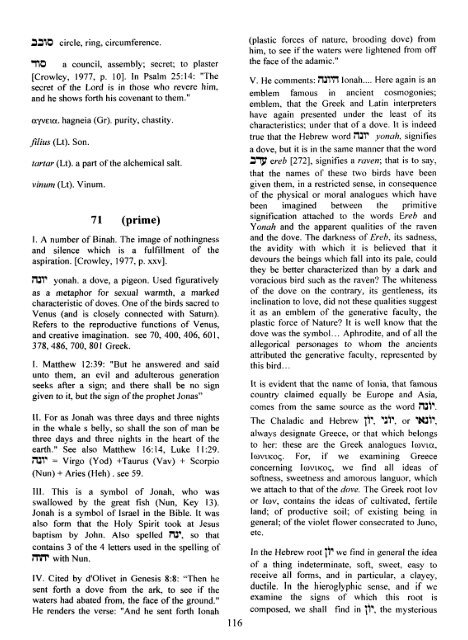Gematria - Sepher Sapphires Volume 1.pdf
Gematria - Sepher Sapphires Volume 1.pdf
Gematria - Sepher Sapphires Volume 1.pdf
Create successful ePaper yourself
Turn your PDF publications into a flip-book with our unique Google optimized e-Paper software.
1170 circle, ring, circumference.<br />
'110 a council, assembly; secret; to plaster<br />
[Crowley, 1977, p. 101. In Psalm 25:14: "The<br />
secret of the Lord is in those who revere him,<br />
and he shows forth his covenant to them."<br />
ayveta. hagneia (Gr). purity, chastity.<br />
firius (Lt). Son.<br />
tartar (Lt). a part of the alchemical salt.<br />
vinum (Lt). Vinum.<br />
71 (prime)<br />
I. A number of Binah. The image of nothingness<br />
and silence which is a fulfillment of the<br />
aspiration. [Crowley, 1977, p. xxv].<br />
?Ill' yonah. a dove, a pigeon. Used figuratively<br />
as a metaphor for sexual warmth, a marked<br />
characteristic of doves. One of the birds sacred to<br />
Venus (and is closely connected with Saturn).<br />
Refers to the reproductive functions of Venus,<br />
and creative imagination. see 70, 400, 406, 601,<br />
378,486, 700,801 Greek.<br />
1. Matthew 12:39: "But he answered and said<br />
unto them, an evil and adulterous generation<br />
seeks after a sign; and there shall be no sign<br />
given to it, but the sign of the prophet Jonas"<br />
11. For as Jonah was three days and three nights<br />
in the whale s belly, so shall the son of man be<br />
three days and three nights in the heart of the<br />
earth." See also Matthew 16:14, Luke 11:29.<br />
?Iflq = Virgo (Yod) +Taurus (Vav) + Scorpio<br />
(Nun) + Aries (Heh) . see 59.<br />
111. This is a symbol of Jonah, who was<br />
swallowed by the great fish (Nun, Key 13).<br />
Jonah is a symbol of Israel in the Bible. It was<br />
also form that the Holy Spirit took at Jesus<br />
baptism by John. Also spelled ?If', so that<br />
contains 3 of the 4 letters used in the spelling of<br />
?lW with Nun.<br />
IV. Cited by d'Olivet in Genesis 8:8: "Then he<br />
sent forth a dove from the ark, to see if the<br />
waters had abated from, the face of the ground."<br />
He renders the verse: "And he sent forth Ionah<br />
116<br />
(plastic forces of nature, brooding dove) from<br />
him, to see if the waters were lightened from off<br />
the face of the adamic."<br />
V. He comments: 331V Ionah .... Here again is an<br />
emblem famous in ancient cosmogonies;<br />
emblem, that the Greek and Latin interpreters<br />
have again presented under the least of its<br />
characteristics; under that of a dove. It is indeed<br />
true that the Hebrew word 327' yonah, signifies<br />
a dove, but it is in the same manner that the word<br />
1ft ereb [272], signifies a raven; that is to say,<br />
that the names of these two birds have been<br />
given them, in a restricted sense, in consequence<br />
of the physical or moral analogues which have<br />
been imagined between the primitive<br />
signification attached to the words Ereb and<br />
Yonah and the apparent qualities of the raven<br />
and the dove. The darkness of Ereb, its sadness,<br />
the avidity with which it is believed that it<br />
devours the beings which fall into its pale, could<br />
they be better characterized than by a dark and<br />
voracious bird such as the raven? The whiteness<br />
of the dove on the contrary, its gentleness, its<br />
inclination to love, did not these qualities suggest<br />
it as an emblem of the generative faculty, the<br />
plastic force of Nature? It is well know that the<br />
dove was the symbol.. . Aphrodite, and of all the<br />
allegorical personages to whom the ancients<br />
attributed the generative faculty, represented by<br />
this bird.. .<br />
It is evident that the name of lonia, that famous<br />
country claimed equally be Europe and Asia,<br />
comes from the same source as the word 321'.<br />
The Chaladic and Hebrew ii', 'fi', or 'Nfi',<br />
always designate Greece, or that which belongs<br />
to her: these are the Greek analogues Iovta,<br />
lovt~oq. For, if we examining Greece<br />
concerning Iovt~oq, we find all ideas of<br />
softness, sweetness and amorous languor, which<br />
we attach to that of the dove. The Greek root Iov<br />
or lov, contains the ideas of cultivated, fertile<br />
land; of productive soil; of existing being in<br />
general; of the violet flower consecrated to Juno,<br />
etc.<br />
In the Hebrew root ii' we find in general the idea<br />
of a thing indeterminate, soft, sweet, easy to<br />
receive all forms, and in particular, a clayey,<br />
ductile. In the hieroglyphic sense, and if we<br />
examine the signs of which this root is<br />
composed, we shall find in ii', the mysterious


